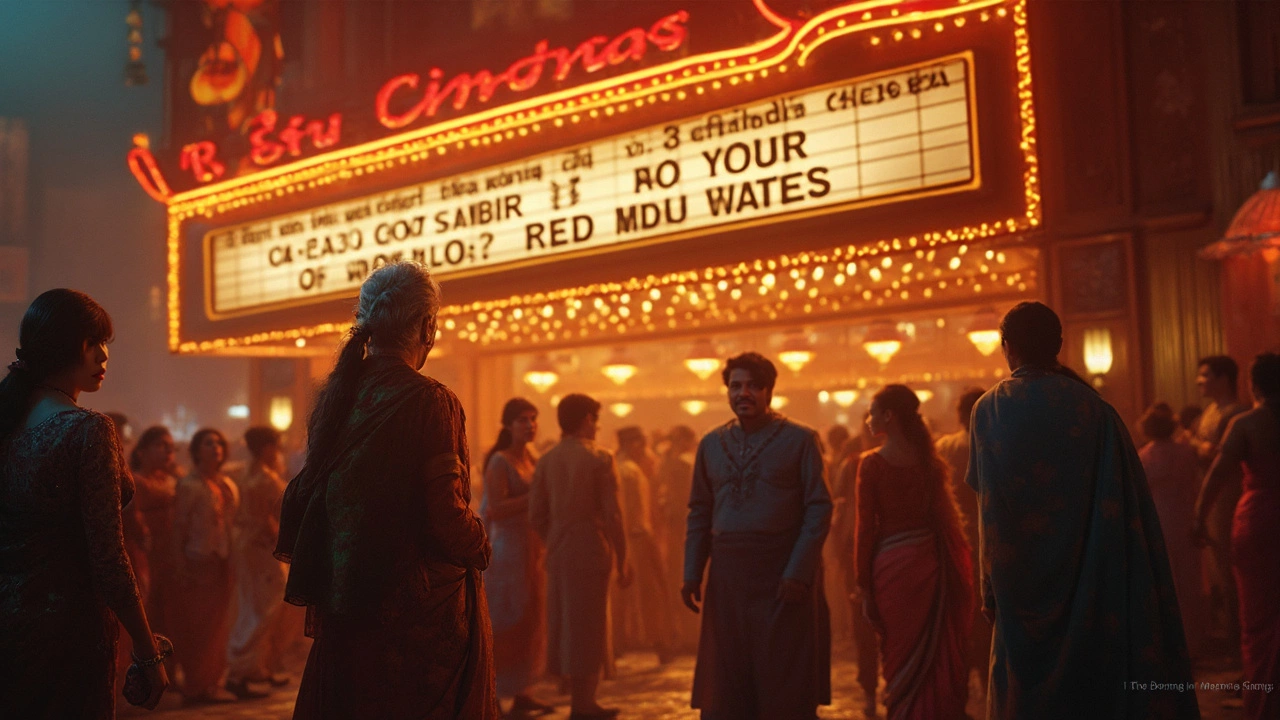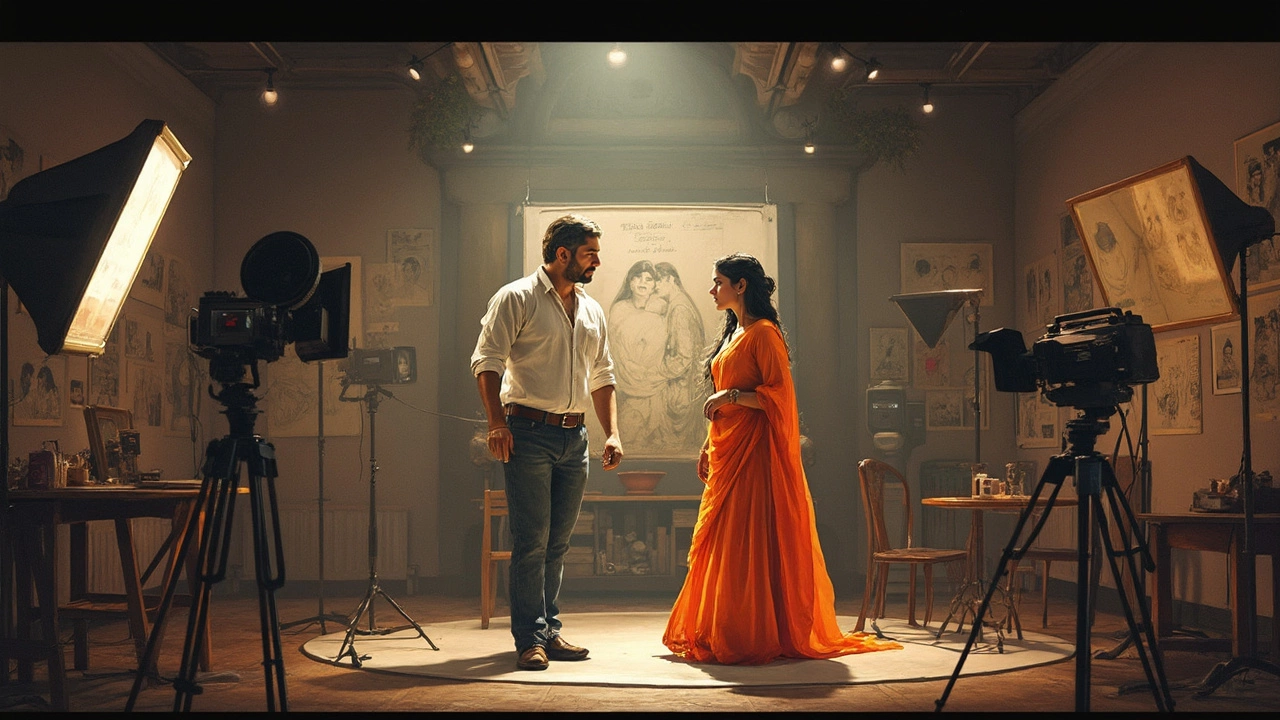The Most Re-Released Indian Movie: A Deep Dive
 Mar, 26 2025
Mar, 26 2025
Ever wondered which Indian movie holds the record for being the most re-released? It's a title that many might not expect but is cherished by generations. Heading the list is 'Sholay', a movie that has repeatedly captivated audiences since its original release in 1975. Imagine, this film has been brought back to cinemas multiple times over the decades, each time drawing fans new and old.
So, why exactly does 'Sholay' keep coming back to the big screen? It's a mix of its gripping storyline, unforgettable characters, and heart-stopping action scenes. Not to mention, the film's quote-worthy dialogues have become a part of everyday conversation in India. It's as if each re-release lets us rewind time and experience the magic as if it were the first time.
- The History of Re-Releases
- Spotlight on the Most Re-Released Movie
- Why Re-Releases Matter
- The Cultural Significance
The History of Re-Releases
Throughout the vibrant history of Indian cinema, the concept of re-releasing movies has played a pivotal role in how films are appreciated and remembered. It's not just about keeping older films in circulation but also about celebrating and reintroducing them to newer generations.
Back in the golden era of Bollywood, say the 1950s and 1960s, films were released with limited prints. That's why when a movie gained popularity, it often had numerous re-releases to reach more audiences. This was less about nostalgia—though the charm was undeniable—and more about economics and demand.
The Advent of Re-Releases Due to Nostalgia
By the 1980s and 1990s, as technology brought color television and video cassettes into homes, re-releases took on another flavor. It wasn't just about accessibility anymore. People wanted to relive the magic of iconic films in theaters, prompting re-releases of classic hits like *Sholay* and *Mughal-e-Azam*. These films weren't just stories; they were experiences, best enjoyed on the big screen.
Modern-Day Re-Releases
These days, re-releases often come with a fresh twist. Digitally remastered versions are now the trend, giving classics a polished, contemporary feel. Not to mention 3D conversions that invite us to revisit these old favorites with new eyes. In this format, we've seen films like 'Dilwale Dulhania Le Jayenge' back in theaters, where it belongs.
| Era | Reason for Re-Release |
|---|---|
| 1950s-1960s | Extended Audience Reach |
| 1980s-1990s | Nostalgia & Revival |
| 2000s-Present | Digital Remastering & Experiencing in 3D |
The re-release culture shows just how impactful a Bollywood movie can be across different eras. It underlines the timelessness of certain stories and the irreplaceable experience of a cinema hall setting. So next time you're in the queue for a re-released film, know that you're part of a continuing tradition that honors India's rich cinema heritage.
Spotlight on the Most Re-Released Movie
When it comes to re-releases in Bollywood movies, 'Sholay' stands in the spotlight. Released back in 1975, this film has become a cultural phenomenon, appealing to audiences of all ages even today. It was directed by Ramesh Sippy and stars some of India's most iconic actors like Amitabh Bachchan, Dharmendra, Hema Malini, and Amjad Khan.
Let's break down why 'Sholay' has this amazing staying power. First and foremost, its storyline is timeless. The movie brilliantly combines elements of action, adventure, and comedy, making it a complete package. The friendship between Jai (Amitabh Bachchan) and Veeru (Dharmendra) is legendary and has inspired countless other films in Indian cinema.
The Impact of Characters and Dialogue
Each character in 'Sholay' is memorable, thanks in part to the sharp dialogues that have echoed through the years. Gabbar Singh, portrayed by Amjad Khan, introduced a villain that audiences love to hate, with lines like "Kitne aadmi the?" becoming a staple in Hindi conversations. It's these elements that have transformed 'Sholay' into more than just a movie; it's an experience that fans want to relive, urging cinemas to bring it back regularly.
The Box Office Journey
The financial journey of 'Sholay' also tells an interesting story. Despite an average start, it quickly gained traction and soon became one of Bollywood's biggest blockbusters. Over the years, with multiple re-releases both in traditional theatres and modern multiplexes, 'Sholay' has stayed relevant, consistently drawing in enthusiastic crowds.
Sholay's Timeless Appeal
Why does Indian cinema keep gravitating back to this film? Some say it's the nostalgia; others point to the sheer entertainment value. It could be the allure of Bollywood's golden age, which this film perfectly encapsulates. With the increased availability of classic movies on various platforms, 'Sholay' continues to attract new fans, proving it's more than capable of standing the test of time.
Whatever the reasons, 'Sholay's' status as the most re-released movie is a testament to its enduring allure in Indian cinema. It's proof that when a film nails its formula, it can transcend generations.

Why Re-Releases Matter
Have you ever thought about why some movies don't just fade into obscurity but keep coming back? In Bollywood, re-released films like 'Sholay' continue to thrive because they manage to tug at the heartstrings of audiences, both young and old. This phenomenon isn't just about nostalgia; it's about keeping culture alive.
Creativity and Innovation
Re-releases often come with updated features—think remastered soundtracks or enhanced visuals. Some films even get a 3D makeover. These improvements can breathe new life into a classic, attracting fans eager to see beloved scenes with modern twists. It's a little like mixing vintage charm with today's tech.
Box Office Boost
Re-releases are a financially smart move. These films, which have already proven box office success, offer a safer bet than untested new releases. Post-pandemic, cinema halls have found them an excellent way to pull crowds and revive ticket sales, highlighting the economic sense behind reviving past hits.
Nostalgia and New Discoveries
For older audiences, re-releases serve as a trip down memory lane, reliving the excitement they first felt. For younger audiences, however, they are a window into a different era, offering a chance to pick up references or understand cultural tropes that older generations grew up with. It bridges generational gaps.
Tables: Impact on Box Office
| Movie | Re-Release Years | Box Office Gain (INR Crores) |
|---|---|---|
| Sholay | 1975, 1985, 1995, 2004, 2014 | 30 |
| Mughal-e-Azam | 1960, 2004 | 7 |
The impact of re-releases on Bollywood isn't just about the extra bucks; it's about preserving cinematic legacy. In many ways, these re-releases have ensured that Indian cinema remains vibrant and continues to inspire new filmmakers and audiences alike.
The Cultural Significance
Diving into the cultural impact of Sholay, it's easy to see why it continually finds its way back into theaters. It's not just a movie; it's a phenomenon that shaped Indian cinematic history. Released in the mid-70s, it was a time when Bollywood was dominated by a certain kind of storytelling. Sholay broke the mold with its spaghetti Western style, drawing huge audiences nationwide.
This film did more than entertain; it mirrored societal concerns and values of its time. It touched upon themes like friendship, revenge, and justice, which resonated deeply with people. The epic friendships depicted by the legendary characters, Jai and Veeru, became the gold standard for bromance on screen.
Impact on Pop Culture
Quotes and scenes from Sholay have seeped into daily life, becoming a part of India's social fabric. Ever heard "Kitne aadmi the?" or "Yeh haath mujhe de-de Thakur" around a friend's living room? These lines have achieved cult status and are often recited with fond nostalgia.
- Bollywood icons: Stars like Amitabh Bachchan and Dharmendra became household names, solidifying their status as Bollywood legends.
- Enduring music: The film's soundtrack, composed by R. D. Burman, includes evergreen hits that are still played and remixed today.
A Reflection of Changing Times
The re-releases of Sholay are a testament to its timelessness. Each comeback isn't just about nostalgia but also about introducing this piece of iconic cinema to new generations. It's fascinating how a film from 1975 continues to spark discussions about good versus evil, loyalty, and courage.
Its ability to cross generational divides highlights the film's rootedness in cultural memory, and its re-releases emphasize the persistent demand for stories with depth and entertainment. How many other movies can say they've kept audiences thrilled for decades? So next time you hear about a Sholay screening, consider it more than just another release – it's an invitation to partake in a legacy.